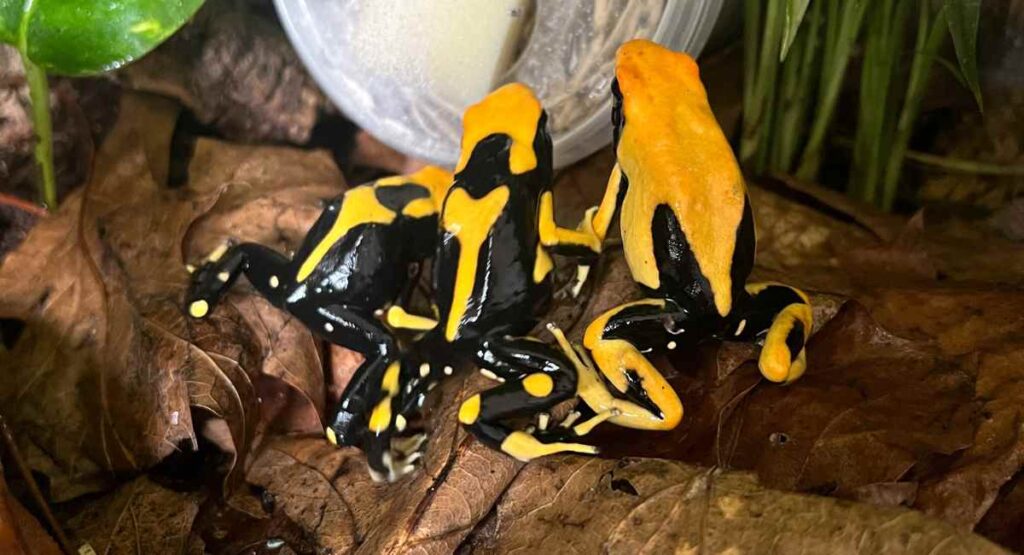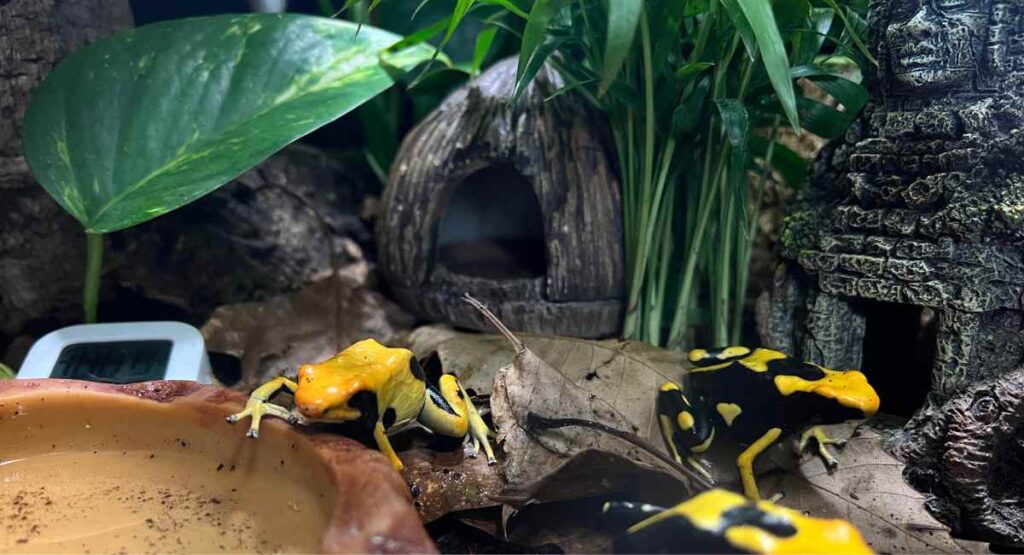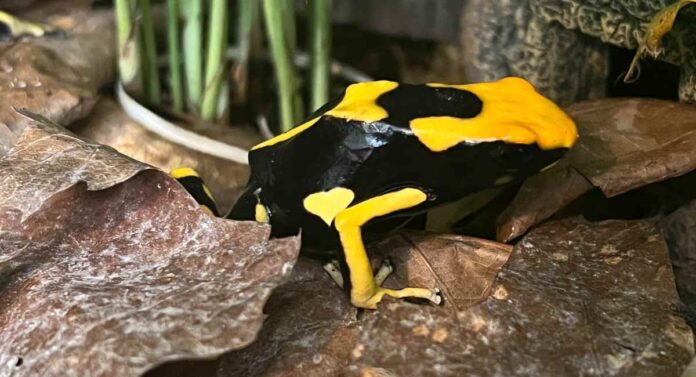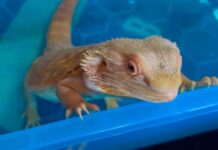The best poison dart frog pet is the Dendrobates tinctorius Matecho. My bright yellow and black frogs are confident, very active and enthusiastically try to climb onto my hands or jump into my lap whenever I open their bioactive tank. Dendrobates tinctorius are large for the poison dart frog group, so you feel more confident interacting with them, even though you still need to be careful with these porous skinned amphibians.
The Matecho color variety comes in a large range of patterns, so I can easily tell my three beautiful ladies apart. I can’t wait to convince you that you’ll love these cute critters as much as I do!
Contents
Dendrobates tinctorius love exploring their enclosure, climbing, eating fruit flies and even interacting with their human friends. I researched for a long time before settling on this type as the best poison dart frog pet. And I’m confident I chose the perfect pet Dart Frogs. The Matecho variety’s colors are standout awesome, just like their personalities, and they even have a dash of dark orange on their lips and adorable purple tongues that blep out as they catch flies. And they never try to eat me, unlike some of my other frog species!
My poison dart frog pets are all female, so they don’t make any noise. The males however do call, and it is a distinctive chirping noise that can happen at any time of the day or night. I don’t find it offensive, but if you are a fan of silent nights it is something to consider.
Are Poison Dart Frogs Dangerous Pets?
I just want to clear this one up quickly. Pet dart frogs are not poisonous. They are only potentially poisonous in their natural environment, as a result of their wild diet. In captivity they are totally harmless.
And in fact, a poisonous animal would only be dangerous if you ate it, licked it, or for some reason decided it would be fun to rub it on your eyeballs! Venom is injected through bites, poison has to be ingested. But either way – science lesson over, your pet dart frog is not a risk to your safety. Well, only through cuteness overload!
Colorful Matecho Dart Frogs
The best poison dart frog pet has to be one with amazing colors. There are several types of Dendrobates tinctorius, and they differ only in terms of color pallette and patterns. Blues and yellows are commonly seen, sometimes together, but the Matecho has the most striking pattern and to my mind the most variation within the type.
I can easily tell my Dendrobates tinctorius dart frogs apart. You’ve got Lexi, who has fairly even amounts of black and yellow. Lara is predominantly yellow, with just a black belly and legs. And then there is Nemi, like her namesake mostly in black.

Confident Personalities
The best poison dart frog pet is one that you get to appreciate. And Dendrobates tinctorius are known for being a little more forward than some of the other poison dart frog varieties. And technically speaking, the difference between a Matecho and an Azureus for example is just the color. They are the same species, and if you put them into the same enclosure these dart frogs can interbreed. However, I only know of one other collection of Matecho dart frogs like mine, and they are also always at the front of the tank asking for food and attention. Their confidence far outstripping the other types I’ve met.
My dart frogs as you’ll see in the video at the start of this article are really friendly. They strongly associate me with food, and I never attempt to interact with them unless they are already out and interested in what i’m doing. I do let them jump onto my hands occasionally, but I make sure they are dry with no soap residue beforehand. Ideally if i wanted to lift them out the enclosure for any time I would wear rubber gloves to protect their delicate skin.
Bioactive Tanks Are The Best
I have a strong preference for keeping my amphibians in bioactive enclosures. A bioactive setup is one which contains essentially a full ecosystem. Live plants, custodian invertebrates and a carefully separated drainage layer that allows water to pass through the soil but not sit in it creating a bog.
A great saying to remember when maintaining the tank is ‘dry feet, damp backs’. The best way to achieve this beyond the bioactive setup is lots of dried leaf litter on the floor. This will keep the frogs feet from getting wet.

Dart Frog UVB, Temperature and Humidity
Dart frogs live happily at room temperature, assuming you keep your home fairly warm but not boiling hot. They need spraying down once a day with a hand held misting bottle, and this water along with that in their water dish needs to have tap water chemicals removed. I used Reptisafe for this, but there are several other brands available.
I provide an arcadia UVB strip over my dart frog enclosure. This helps the plants, but it’s also great for your little dart frogs. Ensure they have plenty of places to hide and seek shade if they decide, but also the opportunity to bask in the UVB light if they choose to.
Feeding your Pet Dart Frogs
My Dendrobates tinctorius dart frogs eat exclusively fruit flies. You can offer them pinhead crickets, locusts or tiny worms, but I find they do best on flies.
I try to buy flightless fruit flies for the convenience, but they can eat any variety that is small enough to be easily fitted in their mouths. They catch the flies by jumping around the area they are in, and quickly whipping out their deep purple tongues. It’s fascinating to watch, and literally hours of fun to observe because they need to hunt for quite a few of the little critters to keep them going.
Adult dart frogs need feeding three to four times per week, depending on how much food they are being offered. I do this by eye, tapping the fruit flie container over the pot to shake out a bunch. We tend to feed them one weekend day a week, and then on a Monday, Wednesday and Friday, or a Tuesday and Thursday.
I dust my dart frog’s flies once a week with supplement powder, and it makes no difference to their enthusiasm to eat. What it does do, is stop the flies from buzzing away when I don’t manage to pick up flightless fruit fries!















